Unit 1 :Set IR of real numbers
1.0 Introductory activityFrom the following diagram, discuss and work out the given tasks:
1. How many sets of numbers do you know? List them down and give
reasons for your answer.
2. Using a mathematical dictionary or the internet, define the sets of
numbers you listed in (1).
3. Give an example of element for each set of numbers you listed.4. Establish the relationship between the set of numbers that you listed.
Objectives
After completing this unit, I will be able to:
» Define absolute value of a real number and solve
simple equations involving absolute value.
» Define powers and their properties.
» Define radicals and their properties.
» Define decimal logarithms of a real numbers andsolve simple logarithmic equations.
1.1. Subsets and properties of operations in the set real numbers
Activity 1.1
a. Carry out a research on sets of numbers to determine the meaning of
natural numbers, integers, rational numbers and irrational numbers.
Use knowledge from your findings to classify numbers in the givenlist into natural numbers, integers, rational numbers and irrational




The following table shows the addition, subtraction, multiplication anddivision of real numbers and the related properties.



Application Activity 1.1
1. Plot a number line and locate elements of the following subsets ofreal numbers.

1.2. Positive and negative numbers
Activity 1.2
1. By means of thermometer, a Doctor recorded the temperature of a patientat different times of the same day.

a) When the lowest temperature of a patient was recorded?
b) What was the difference in temperature between 6:00 and 21:00?
c) What was the difference in temperature between 9:00 and 12:00?
d) At midnight the temperature was 0.25 degrees above 21:00. What was
the temperature at midnight?
Extreme high and low temperatures contribute directly to deaths from
cardiovascular and respiratory disease, particularly among elderly
people. In Quebec, Canada, it was observed that on July 6th 1921 the
highest temperature recorded in Ville-Marie was 40 oC and on February
5th 1923 the lowest temperature recorded in Doucet was -54.4 oC. Do you
think this records can happen or was happened in Africa? Consult the
link (https://en.wikipedia.org/wiki/List_of_countries_and_territories_
by_extreme_temperatures) and find out the lowest temperature(oC)
recorded on January 28th 2005 in Mecheria , Algeria and the lowesttemperature(oC) recorded on February 11th 1935 in Ifrane, Morocco.
The most commonly used numbers in arithmetic are integers, which are
positive and negative whole numbers including zero. Positive integers
are 1, 2, 3, 4, 5 and so on. The negative integers are -1, -2, -3, -4, -5 and
so on.
Integers (positive and negative numbers) can be represented on a
number line and the number line can be used to perform addition and
subtraction.
Example 1.1:
1) Use a number line, locate -2 and -5. Then perform the following
operation using a number line: (-2)+(-5)=
Solution
“negative 2 minus negative 5” meaning that (-2) + 5 (adding theopposite).
Integers (positive and negative numbers) have the real-life applications
and situations where one can find the use of plus and minus-valuedintegers.
• When scientists measure the temperature of the water and some
chemical compound, then the mixture is said to be cold, if the
thermometer (or any other measuring device) gives a negative
value.
• −67.8 °C (−90.0 °F) is the record temperature of Verkhoyansk and
Oymyako of the country Russia. Here, even countries and many
cities of the world are represented using negative numbers for
freezing climates and positive numbers for hot summer weather.
• During banking or when involved in any other financial procedures,
minus sign denotes debit value and the positive sign represents a
credit value. So, if the balance check sheet for your debit card
states – 14 500, then you have a loan amount of 14 500 Frw to be
debated in the bank.
Application Activity 1.2
1. Water freezes at 0oC. Is the temperature in a freezer,
a) Equal to 0oC?
b) Lower than 0oC?
c) Greater than 0oC?
2. Here are six temperatures, in Celsius degrees.
6 -10 5 -4 0 2
Write them in order, starting with the lowest.
3. Here are the midday temperatures, in degrees Celsius, of five citieson the same day.
a) Which city was the warmest?
b) Which city was the coldest?
c) What is the difference between the temperatures of Berlin and
Boston?
4. Some frozen food is stored at -8oC. During a power cut the
temperature increases by 1oC every minute. Copy and completethis table to show the temperature of the food.
5. In a certain city, the temperature was -7 oC in the morning and
dropped by 10oC in the afternoon. What is the new temperature?1.3. Rounding and estimating decimal numbers.
Activity 1.3
As a pharmacy technician, you will encounter decimals nearly every
day. Medications are frequently prescribed in decimals, and you will
find that many dosage calculations will be worked out using thedecimal format.
1. Use calculator to work out

What do you notice?
2. How can you write the answer for instance when dividing 22 by 7,
calculating square root of 3 ? Explain?
The word “Decimal” means “based on 10” and comes from the Latin
word: decima which means «a tenth part”. Decimal numbers are used
in situations which call for more precision than whole numbers provide.
As with whole numbers, a digit in a decimal number has a value which
depends on the place of the digit. The places to the left of the decimal
point are ones, tens, hundreds, and so on, just as with whole numbers.
The following illustration shows the decimal place value for variouspositions:
Each digit in a number has a ‘place value’ (related to one). The value
depends on the position of the digit in that number. Each position can
be thought of as columns. Each column is a power of ten.For example, let’s look at 56.39
A recurring decimal is a decimal fraction where a digit repeats itself
indefinitely.
Rounding numbers is a method of summarizing a number to make
calculations easier to solve. Rounding decreases the accuracy of a
number. Rounding to a specified integer or decimal is important whenanswers need to be given to a particular degree of accuracy.
The Rules for Rounding:
1. Choose the last digit to keep.
2. If the digit to the right of the chosen digit is 5 or greater, increase the
chosen digit by 1.
3. If the digit to the right of the chosen digit is less than 5, the chosen
digit stays the same.
4. All digits to the right are now removed.
Example 1.3
What is 7 divided by 9 rounded to 3 decimal places?
Solution
7÷ 9 =0.7777777...
So, by respecting rule 2, then 7÷ 9 = 0.778
Estimating decimal numbers.
Estimating is a very important skill in solving Mathematics problems. It helps
to be able to estimate the answer to check if your calculations are correct.
Some simple methods of estimation:
• Rounding
Example 1: 273.34+ 314.37=?
If we round to the tens We get 270 +310 which is much easier and
quicker. We know that 273.34 +314.37 should equal approximately 580.
• Compatible Numbers
Example 2: 527× 12 ?
1.4. Fractions and equivalent fractions
Activity 1.4Refer to the figures and answer the related questions
a) What fraction of the large square is black?
b) What fraction of the large square has vertical lines?
c) What fraction of the large square has diagonal lines?
d) What fraction of the large square has wavy lines?
e) What fraction of the large square has dots?
f) What fraction of the large square is unshaded?
g) What fraction of the large square has the horizontal line?h) What is the relationship between
• Fractions are representations of “parts of a whole”. A fraction is a part of a
whole: the denominator (bottom number) represents how many equal parts
the whole is split into; the numerator (top number) represents the amount of
those parts
• Equivalent fractions are two or more fractions that are all equal.
The second figure in activity above shows that each row has been
split into different fractions: top row into 2 halves, bottom row 12twelfths. An equivalent fraction splits the row at the same place.
therefore are all equal and equivalent fractions.
are all equal and equivalent fractions.
Doctors often use fractions to figure out what the right dose is. There
is a medicine that can treat patients who are having a stroke (a blood
clot that stops blood flow going to part of the brain). The dose of
the medication is (9/10) times the body weight in kilograms. So if
a patient weighs 70 kg, doctors have to multiply 99/100x (70) = 63
mg of medication. Then (1/10) of that is given right away (6.3 mg),
followed by the rest (63-6.3=56.7 mg) over an hour. The nurses
who give the medication have to do more to figure out how much
medication has to be given every minute on a pump. If there is a
math mistake, then the patient might get too little medication-then
it probably won’t work. If they get too much medication, they might
have bleeding in the brain. So doctors have to be sure they do it right.
Calculators and several people do the math to make sure everyoneagrees
Application Activity 1.4
1. Given . Find the equivalent fraction by multiplying 4.
. Find the equivalent fraction by multiplying 4.
2. The order reads 1/400 gr. The vial is labelled 1/300g =20 drops.How many drops are to be given?
1.5. Ratios, proportions and rates.
Activity 1.5
1. you survey your friends about their favourite course in associate
nursing program and you find that 8 out of 12 prefer Maternal and
Child health.
a) Write in simplest form the fraction that represents those who do
not prefer Maternal and Child health.
b) Which fraction best communicates the survey results?
c) Express to percentage, the fraction of those who prefer Maternaland Child health.
2. At a certain clinic, an hospitalized person had to pay 17,500FRW for
consultation, 45,000FRW for medicine, and 30,000FRW for room in3days. If the patient was insured by RSSB who pay 85% of the cost,
a. How much money did the RSSB pay for the patient?
b. How much money did the patient pay on his/her own?
3. Consider the table below which shows the relationship betweenthe ages (in year) and quantity of medicine (in ml) to be take.
a. Draw the graph of the number of medicine (in ml) against ages
(in year)
b. Describe the graph you have drawn in (a) above.
4. Consider the relationship between the speed and time taken by acar to cover a fixed distance of 320 km.
Take 20 km/h to be the original speed.
(i) What do you notice when the speed is doubled?
(ii) Plot the graph of speed against time.(iii) Describe the graph you drew to your classmates.
5. A pulse is measured as 17 beats over 15 seconds. What is the heart
rate per minute?
1. A ratio is a comparison of two quantities. The ratio of a to b can also
be expressed as a:b or a/b. This relation gives us how many times one
quantity is equal to the other quantity. In simple words, the ratio is
the number which can be used to express one quantity as a fraction
of the other ones.
Ratio Formula:
Assume that, we have two quantities (or two numbers) and we have to
find the ratio of these two, then the formula for ratio is defined as; a:
b ⇒ a/b, where a and b could be any two quantities.
Example 1.5The ratio of 2 to 4 is represented as 2:4 = 1:2.
Example 1.6
Consider a class that has 20 male students and 80 female students. We
can think about this in several ways. We could express this simply as the
ratio of men to women and write the relationship as 20:80 or 20/80. We can
also simplify this by dividing both the numerator and the denominator by a
number that divides evenly into both
the numerator and the denominator.
In this case, we could divide both by 20 to simplify this to a 1:4 ratio
(or 1/4 ratio). This indicates that for every man, there are four women.
We could also consider this from the inverse perspective, i.e., the
number of women relative to the number of men; in this case the ratio
of women to men is 80/20 which is equivalent to 4 to 1, i.e., there are
four women for every man.
Note that Equivalent ratios are ratios that have the same value. Given a
ratio, we can generate equivalent ratios by multiplying both parts of the
ratio by the same value.
2. Proportion is an equation which defines that the two given ratios are
equivalent to each other. A proportion is a type of ratio that relates a part to a
whole.
Proportion Formula:
Assume that, in proportion, the two ratios are a:b and c:d. The
two terms ‘b’ and ‘c’ are called ‘means or mean term,’ whereas the
Example 1.7
The time taken by train to cover 100km per hour is equal to the time
taken by it to cover the distance of 500km for 5 hours. Such as 100km/
hr = 500km/5hrs.
Example 1.8
In the class with 20 men and 80 women, the total class size is 100, and
the proportion of men is 20/100 or 20%. The proportion of women is
80/100 or 80%. In both of these proportions the size of part of the class
is being related to the size of the entire class.
Difference Between Ratio and Proportion
To understand the concept of ratio and proportion, go through thedifference between ratio and proportion given here.
Example 1.9
The information on mortality from bird flu shows that 44 died and the other
79 lived could be expressed as a simple ratio, which compares the number who
died to the number who survived. 44/79 or 44:79 would be two ways of expressing
this simple ratio. The ratio of those who died relative to those who lived was 44
to 79.
Alternatively, we might want to focus on the proportion who lived. In
total, 123 people were infected, and 44 of these died. Therefore, the
proportion who died was 44/123, which could be expressed as a
decimal fraction (0.36) or as a percentage (36%). This proportion is
referred to as the “case-fatality” rate, although strictly speaking, it is a
proportion and not a rate.
3. Rate: Rates are a special type of ratio that incorporate the dimension of
time into the denominator. Familiar examples include measurements
of speed (kilometers per hour.
Example 1.10
If a car travels 24 kilometres in 2 hours, its average speed is a rate of 24
kilometres / 2 hours = 12 kilometres/hr.
Note that some commonly used measurements of health outcomes are
referred to as “rates” even though they are actually proportions.
For example:
• A mortality rate is the proportion of deaths occurring over a span of
time in a population.
• An attack rate is the proportion of people developing an infectious
disease after exposure to a pathogen.
• A case-fatality rate is the proportion of individuals who die after
developing a disease.
Application of ratios, proportions and rates in nursing
Nurses use ratios, proportions and rates when administering medication.
1. Nurses need to be able to understand the doctor’s orders.
Example 1.11
A doctor’s order may be given as: 25 mcg/kg/min. If the patient
weighs 52kg, how many milligrams should the patient receive in one
hour? In order to do this, nurses must convert micrograms (mcg) to
milligrams (mg). If 1mcg = 0.001mg, we can find the amount (in mg)
of 25mcg by setting up a proportion.
2. Nurses use proportions to Calculate Intravenous Infusion rates and drops per
minute (dpm), by considering the following:
• The total volume to be given, which is often written on the
prescription in mLs.• The time over which the volume is to be given, often in minutes
Example 1.12
If 1500mLs of 0.9% sodium chloride fluid is to be given over 10 hours,
what is the infusion rate for delivery? If the IV administration set has a
drop factor of 20, what will you set the drop rate at?
Solution :There are 2 parts to this question1) calculating the infusion rate (mL/hr)
If the drug is in solution (e.g. oral, IV, IM, SC) the correct dose to be
administered, may need to be drawn from a stock solution. This is a
medication solution that contains a ratio of drug (either as solute or
solid) in a diluent (refresh these concepts in section 10 Dilutions usingthe expression solute in diluent).

Example 1.13
Mr. Small weights 60kg. He has been ordered a drug with a dosage of
10 mg per kg. How much drug should be administered? If the drug
is available in a stock solution of 250mg/5mL, what volume of drug
solution should be administered?
Solution: There are two parts to this question1) The dose of drug to give (in mg);
Application Activity 1.5
1. A first year, physiology subject has 36 males and 48 females, whereas
the clinical practice subject has 64 males and 80 females. You are
asked to work out which cohort has the largest male to female ratio.
2. Yasmin is checking the IV fluid infusion on Mrs Cannon at the start
of the shift. She sees from the fluid balance sheet that Mrs Cannon
has received 320 mL over the past 4 hours. Mrs Cannon is to receive
the full litre bag. How many hours would you expect it to take to
infuse the full litre?
3. Apply your understanding of proportional thinking to solve the
following:
a) A patient is prescribed 150mg of soluble aspirin. We only have
300mg tablets on hand. How many tablets should be given?
b) A solution contains fluoxetine 20mg/5mL. How many milligrams
of fluoxetine are in 40mL of solution?
c) A stock has the strength of 5000units per mL. What volume
must be drawn up into an injection to give 6500units?
d) An intravenous line has been inserted in a patient. The total
volume to be given is 1200mL over 5hours at a drop factor of
15drops/mL. How many drops per minute will the patient
receive?
e) Penicillin syrup contains 200mg of penicillin in 5mL of water.
If a patient requires 300mg of penicillin how much water will be
required to make the syrup?
4. What fraction of H2 O2is hydrogen? Calculate it’s percentage.
1.6. Absolute value and its properties
Activity 1.6.1
Draw a number line and state the number of units that are between;
Absolute value of a number is the distance of that number from the
original (zero point) on a number line. The symbol is used to denote
is used to denotethe absolute value.

Example 1.15
Find x in the following

There is no value of x since the absolute value of x must be a positive real number.

Properties of the Absolute Value
Opposite numbers have equal absolute value.

1.7. Powers and radicals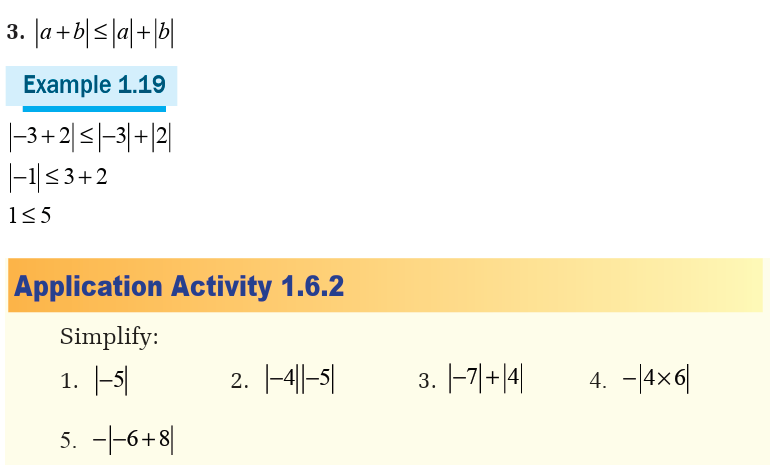
Powers in IR
Activity 1.7.1
Peter suggested that his allowance be changed. He wanted $2
the first week, with his allowance to be doubled each week. Hisparent investigated the suggestion using this table
1. Complete the table to find how many dollars Peter would be paid each
of the first five weeks.
2. How much would Peter be paid the seventh week? The tenth week?3. Do you think his parent will agree with his suggestion? Explain.




These properties help us to simplify some powers.
There is no general way to simplify the sum of powers, even when the
powers have the same base. For instance, and 40 is
and 40 is
not an integer power of 2. But some products or ratios of powers can besimplified using repeated multiplication model of an
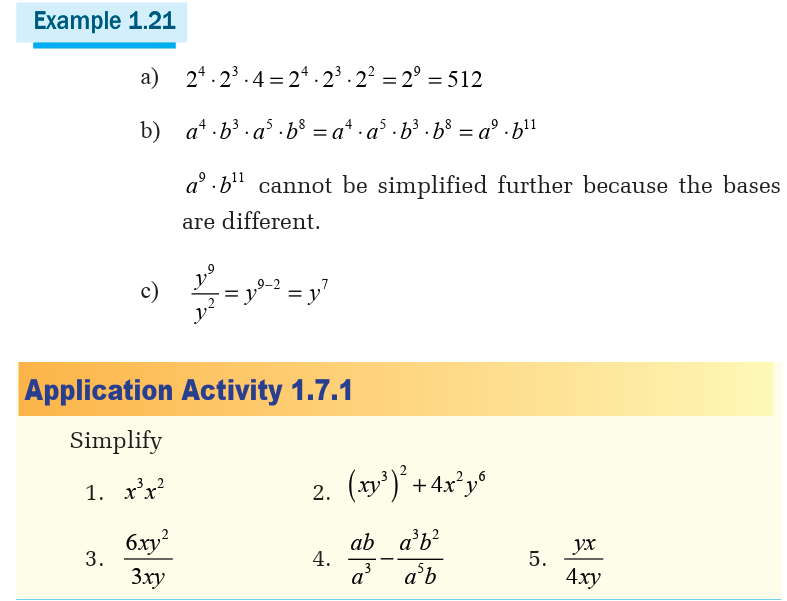
1.A hummingbird has a mass of about 10-2 kg . Show that this mass is 0.01
Radicals in real numbers
Activity 1.7.2Evaluate the following powers
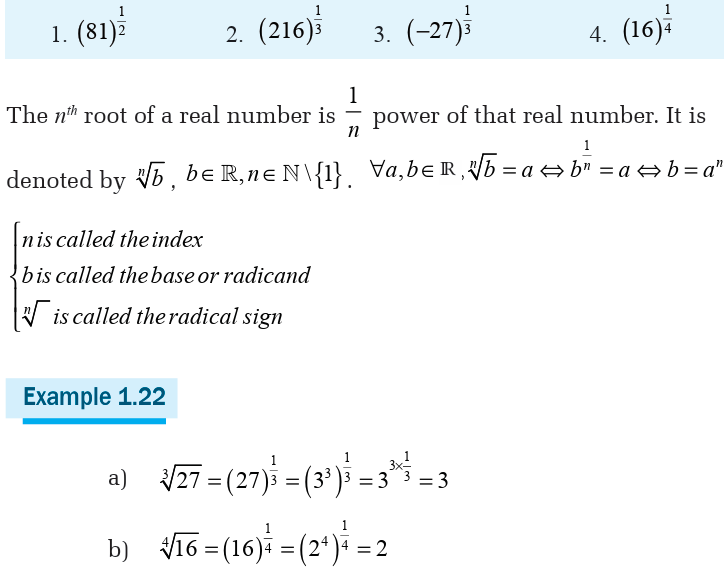
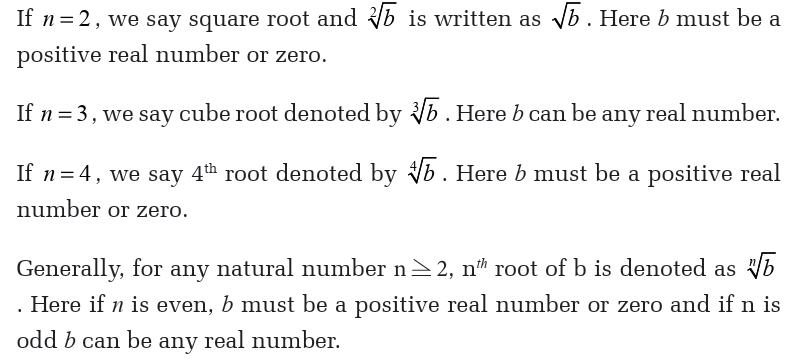
Example 1.23
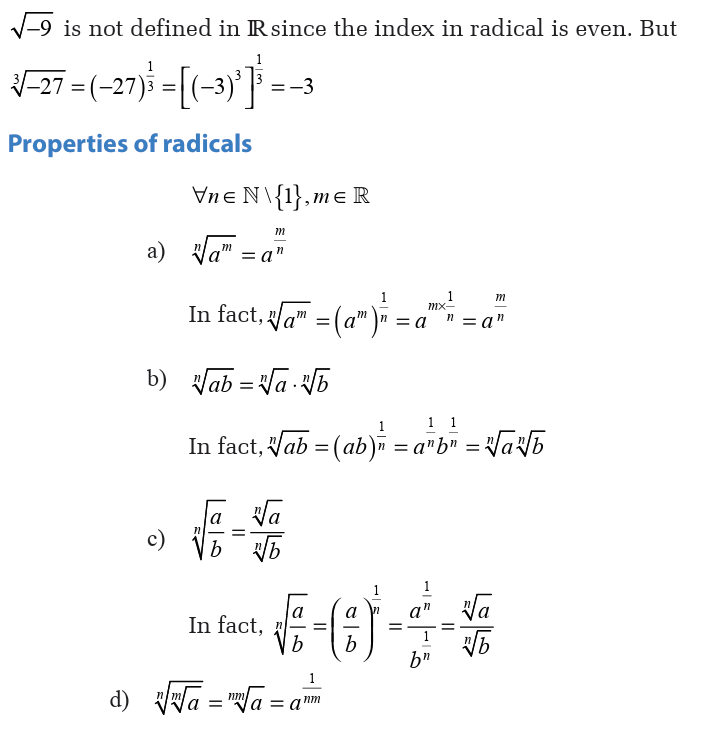
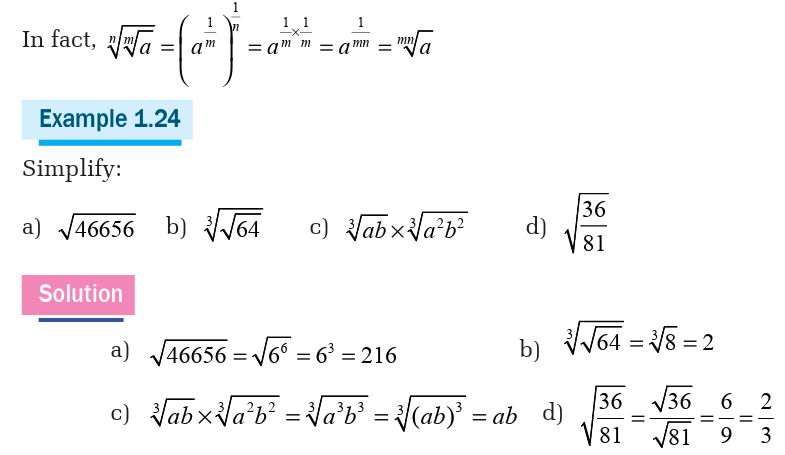
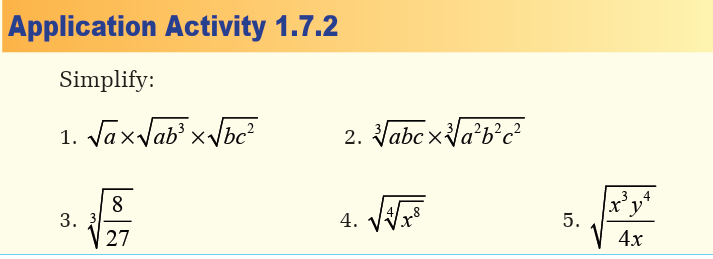
Operations on radicals
When adding or subtracting the radicals, we may need to simplify if we
have similar radicals. Similar radicals are the radicals with the sameindices and same bases.
Addition and subtraction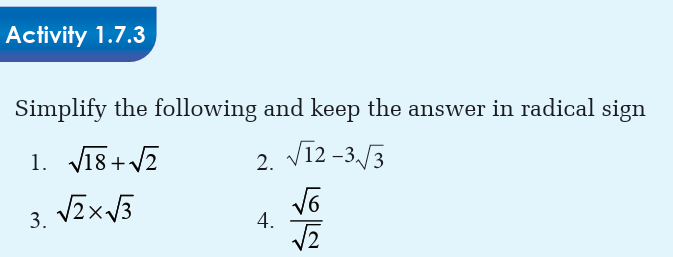
When adding or subtracting the radicals we may need to simplify if we
have similar radicals. Similar radicals are the radicals with the sameindices and same bases.
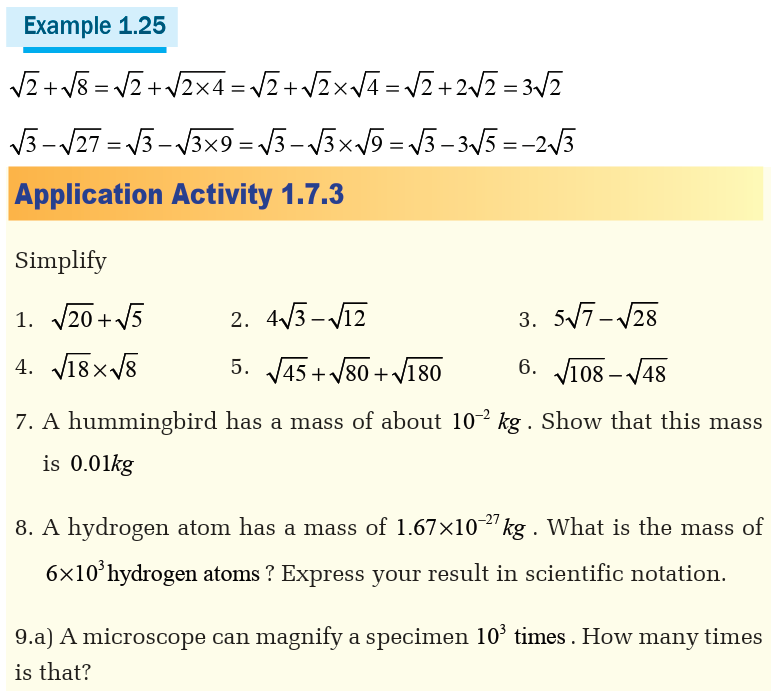

Rationalizing the denominator
Activity 1.7.4Make the denominator of each of the following rational;
Rationalizing is to convert a fraction with an irrational denominator
to a fraction with rational denominator. To do this, if the denominator
involves radicals, we multiply the numerator and denominator by theconjugate of the denominator.
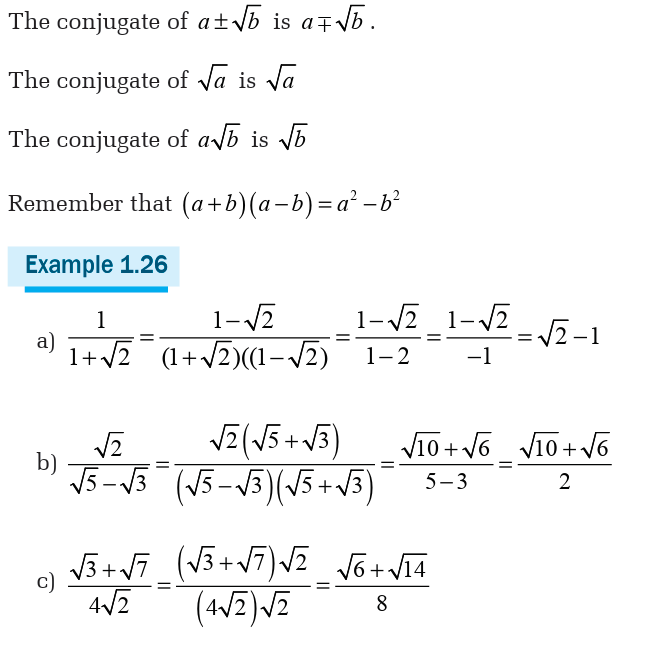
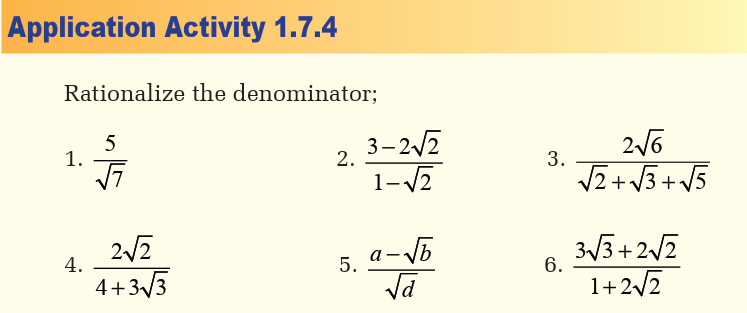

Example 1.27
log (100) = ?We are required to find the power to which 10 must be raised to obtain 100
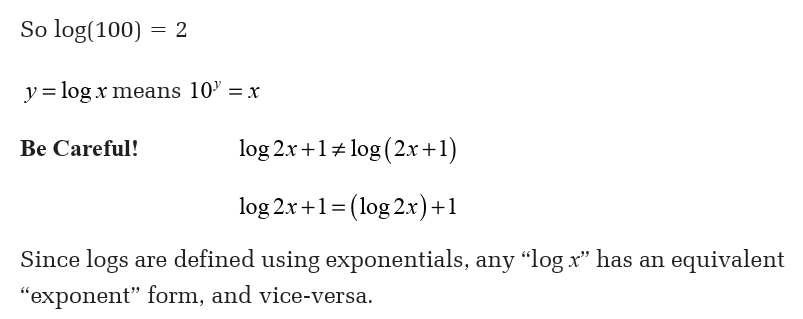
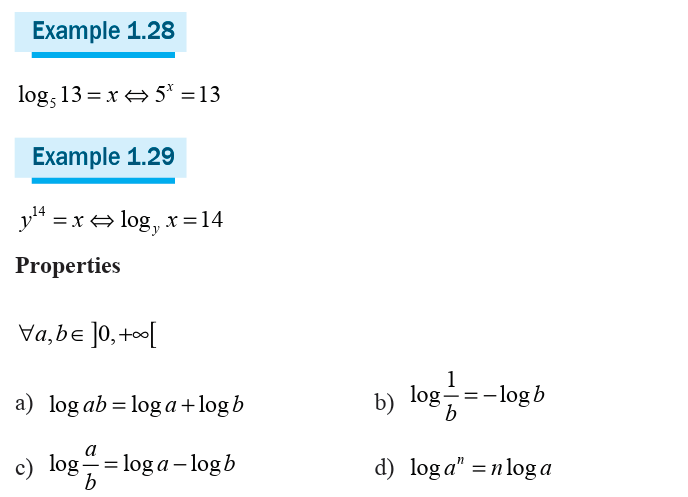

Co-logarithm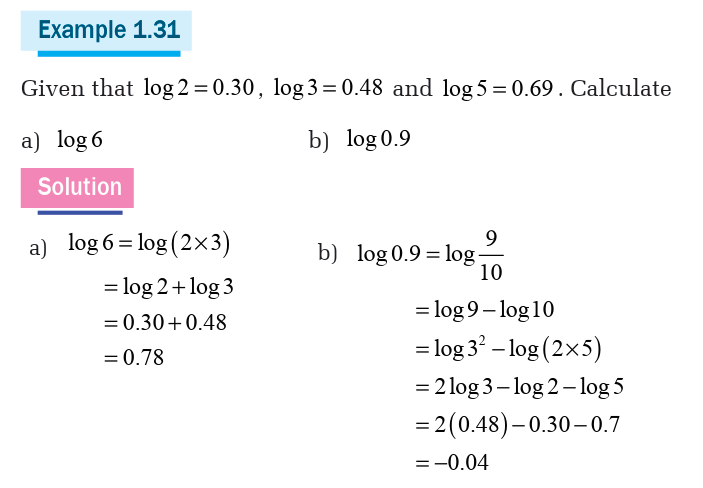
Co-logarithm, sometimes shortened to colog, of a number is the
logarithm of the reciprocal of that number, equal to the negative of thelogarithm of the number itself,
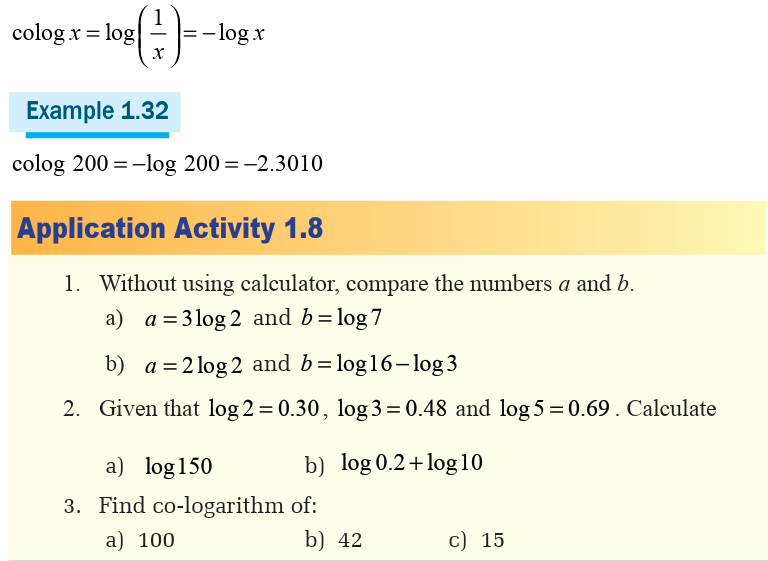
4. Rationalizing is to convert a fraction with an irrational denominator
to a fraction with rational denominator. To do this, if the denominator
involves radicals we multiply the numerator and denominator bythe conjugate of the denominator.
5. The decimal logarithm of a positive real number x is defined to bea real number y for which 10 must be raised to obtain x. We write
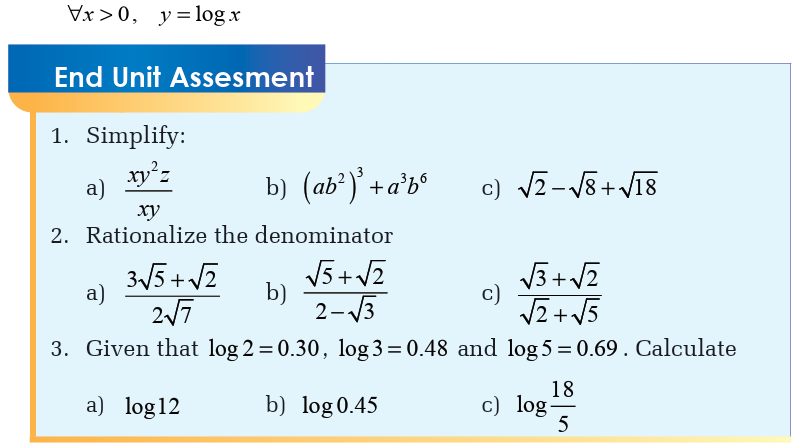
5. Contractors are tilling the bathroom floor in new house. The floor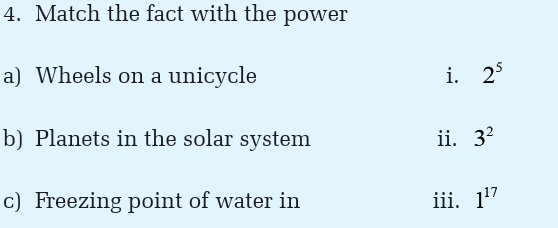
measures 288 cm by 192 cm. They are using square tiles with sides
measuring 24 cm. How many tiles will they need?
6. Esther’s little brother is playing with a set of collared blocks. Each
block has edges measuring 4 cm. What is the volume of one of the
blocks?
7. Humans breathe about 15 breaths in a minute. The average breath at
rest contains 0.76 liter of air. About how many liters of air will you
breathe while at rest for 25 minutes?
8. Density is the ratio of a substance’s mass to its volume. A volume of
20 cubic centimeters of gold has a mass of 386 grams. Express the
density of gold as a unit rate.
9. A lion’s heart beats 12 times in 16seconds. How many times does alion’s heart beat in 60seconds?.
a)How many people were tested negative?
b)How many people were tested positive?
11. Ingabire, Mugenzi and Gahima have jointly invested in buying and
selling of shares in the Rwanda stock exchange market. In one sale
as they invested different amount of money, they realised a gain of
1 080 000 Frw and intend to uniquely share it in the ratio
respectively. How much did Mugenzi get?

